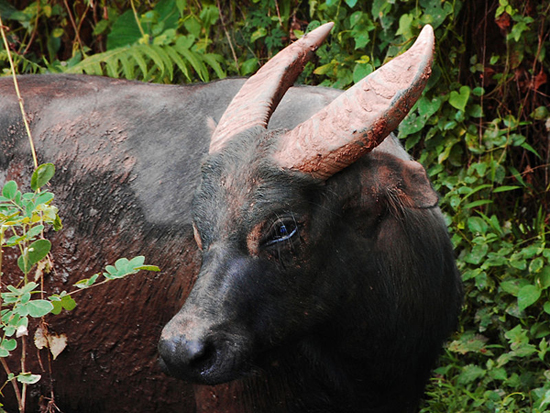Organizations within the international conservation community are joining forces to minimize impending extinctions in Southeast Asia, where habitat loss, trade and hunting have contributed to a dramatic decline in wildlife. The coalition is aptly named ASAP, or the Asian Species Action Partnership.
“ASAP began as a response to alarming results revealed in a 2008 comprehensive assessment for the IUCN Red List of Threatened Species,” Rachel Roberts, International Union for Conservation of Nature’s Species Survival Commission (IUCN SSC) network coordination officer, told mongabay.com.
The assessment revealed a heavy concentration of threatened mammals in Southeast Asia with similar trends observed for other animals. In response, interested conservation organizations came together in a joint call for action.
The emerging program is coordinated by the IUCN SSC on behalf of its member organizations. ASAP will not implement activities directly, but will work to support conservation agencies with programs focused on Southeast Asia’s freshwater and land vertebrates categorized as Critically Endangered on the IUCN Red List of Threatened Species.

One of the only photos of the Critically Endangered saola in the wild taken by camera trap in 1999. First described 1992, the saola is one of the only large-bodied land mammals new to science from the last century, yet its future remains hugely uncertain. Photo courtesy of William Robichaud.
“We hope that ASAP can help mobilize support where it is urgently needed by drawing on the collaborative expertise of conservation practitioners,” Roberts said.
Although still in its infancy, ASAP is quickly coming together. A structure has been created to help define goals, provide expertise and encourage interagency collaboration. The program also identified species on the IUCN Red List that meet ASAP’s criteria for eligibility.
The list contains 154 vertebrates categorized as Critically Endangered that occur regularly in Southeast Asia’s land or freshwater habitats. ASAP will use the list to propel action by matching the conservation needs of these species with improved access to funding and better species-specific information, ultimately gaining high-level political leverage to influence policy and shape interventions.
Many of the species listed are not presently the subject of direct conservation action despite their high risk of extinction. However, there are a few high-profile species with organizations currently concentrating on them, including the Sumatran rhinoceros (Dicerorhinus sumatrensis), tamaraw (Bubalus mindorensis), Siamese crocodile (Crocodylus siamensis), the Mekong giant catfish (Pangasianodon gigas), and several birds.
“Nearly all ASAP species need immediate action now on a much increased scale,” Roberts said.

Orangutan in central Kalimantan. Photo by Rhett A. Butler / mongabay.com.
While ASAP would like to tackle all 154 species on the list, the program may need to prioritize to prevent resources being spread too thinly, resulting in little or no positive impact on a species conservation status, Roberts continued.
“Decisions on how prioritization will occur, if it does, will be taken by the ASAP Steering Committee,” said Will Duckworth, referring to the committee tasked with defining the program’s objectives. Duckworth serves as the ASAP technical coordinator for scientific and technical queries. “This is obviously controversial but the Steering Committee will need to come to a position in this aspect.”
Habitat loss, hunting and trade
The high level of threats across so many species is of particular concern because Southeast Asia is considered an important region for wildlife due to an abundance of biodiversity hotspots. Many species are essential for ecosystems to function effectively and species loss can trigger glitches within the network.
“We recognize that ASAP faces some very stiff challenges by targeting high-risk species already facing a serious threat of extinction,” Roberts said. “Some of our efforts may well prove to be unsuccessful.”
One significant explanation for the region’s elevated threat level is that 47.9 percent of the world’s people live in Southeast Asia or the adjacent countries of China, Bangladesh and India, yet this region makes up only 11.8 percent of the Earth’s land area. Southeast Asia itself supports nearly 9 percent of people with only 3 percent of the Earth’s land, according to a recent report written by Duckworth and partner organizations.

A tamaraw in Mindoro, Philippines, one of the animals on the ASAP list. Photo by Gregg Yan.
Also contributing to species loss is the conversion, fragmentation and degradation of forests, particularly in the lowlands. The forests have been converted to plantation agriculture, mainly oil palm ((Elaeis guineensis), rubber ((Hevea brasiliensis), and pulp and paper concessions.
“Some species are threatened primarily by habitat change, such as lowland forest on level terrain, wide slow-flowing lowland rivers and standing wetlands,” Duckworth said. “Very little such forest is left and even so it continues to be fragmented and degraded.”
Additionally, Southeast Asia and neighboring countries sustain a substantial hunting and wildlife trade demand, according to the report.
“Among land animals, the trade is particularly demanding of large-bodied species without feathers – mammals and reptiles over the size of a squirrel – destined for consumption, to be eaten for a perceived tonic effect,” explains Duckworth. “Not strictly medicine, but certainly not simply food needed to meet basic nutritional needs.”
Trade is also valued among some species for live captives and body parts not meant for eating. Horns and similar trophies like scales from pangolins and otter skins are sought after for display and used as status symbols. With the development of urban markets, the high-demand species have moved from local consumption to long-distance trade.
“The fear is that as larger reptiles and mammals are depleted in Southeast Asia, as well as sourcing them from further afield, smaller species and a broader taxonomic breadth will be involved,” Duckworth noted.
If current trends continue, many Southeast Asian species will become extinct during the next human generation, according to the report.
Duckworth hopes ASAP will help decrease extinctions over the next 10 to 40 years, believing anything that might come from ASAP, for example a strengthened specialist group network or an increased commitment to conservation by donors or governments in the region, are simply much-needed tools to achieve the goal of fewer extinctions.
 Six smugglers sentenced to jail time over pangolin trafficking in Malaysia
Six smugglers sentenced to jail time over pangolin trafficking in Malaysia
(08/20/2013) Six men have been sentenced to a year in jail after being convicted of smuggling 150 pangolins in peninsular Malaysia, reports Annamiticus. The men were also given fines totaling over $100,000.
The Javan Rhino’s final stronghold

(07/29/2013) August 27, 1883. It’s been called ‘the day the world exploded’. One hundred and thirty years ago this month, the volcanic island of Krakatau (Krakatoa) blew its top. The smoking mountain had given several days warning to the human inhabitants of Java and Sumatra, the closest large islands, but no one could have imagined the intensity of the eruption and the devastation that followed. Several cubic miles of rock and ash – more than half the island – rocketed skyward. The explosion released over 10,000 times the energy of the atomic bomb dropped on Hiroshima and was an order of magnitude more powerful than the eruption of Mount St. Helens. Tsunamis greater than 100 feet high roared over coastal habitats, inundating lowland forests and scouring them of wildlife.
Zoos call on governments to take urgent action against illegal wildlife trade (photos)

(07/24/2013) In a single night in March, a band of heavily-armed, horse-riding poachers slaughtered 89 elephants in southern Chad, thirty of which were pregnant females. The carnage was the worst poaching incident of the year, but even this slaughter paled in comparison to the 650 elephants killed in a Cameroon park in 2012. Elephant poaching is hitting new records as experts say some 30,000 elephants are being killed every year for their ivory tusks. But the illegal wildlife trade—estimated at $19 billion—is not just decimating elephants, but also rhinos, big cats, great apes, and thousands of lesser-known species like pangolins and slow lorises. This growing carnage recently led to representatives of over 40 zoos and dozens of wildlife programs to call on governments around the world to take immediate action on long-neglected wildlife crime.
First ever pangolin conference concludes all eight species in trouble
(07/23/2013) Demand for scales, meat, and even fetuses of pangolins have pushed all eight species of this unique mammalian order—Pholidota—toward extinction, according to the world’s first ever pangolin conference with the International Union for Conservation of Nature – Species Survival Commission (IUCN-SSC) Pangolin Specialist Group. Meeting in Singapore earlier this month, 40 conservationists from 14 countries discussed the plight of these little-known scaly mammals and how to turn around their global decline.